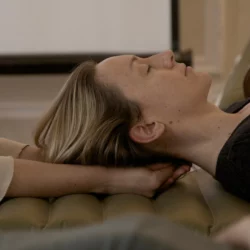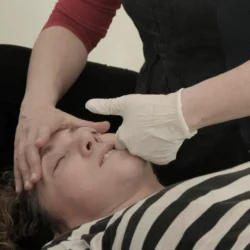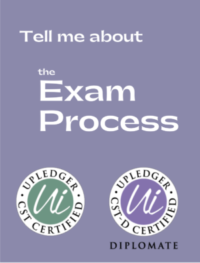The Classes in our Core Curriculum
Whether you are already a therapist interested in the Core Pack, or wanting to Train from Scratch, the classes you do are the same.
Here’s a summary of the skills you learn about in each class:
In CST1:
You will understand the importance of the cerebrospinal fluid and the way it flows, and learn how to feel the rhythm it creates in the body – we call it the craniosacral rhythm.
For everything we teach (in all the courses) you will hear about it (theory behind it, relevant anatomy, technique instructions), see it done (a hands on demo by the instructor), and then do it yourself (swapping the experience with a colleague under the supportively eagle eyes of instructors and assistants).
We review techniques the following morning and you get a chance to recap most of it on the last day, incorporating it into final sessions.
All the while you will be experiencing the paradoxical profundity of a light touch! You will be amazed and delighted at how much you can feel and the changes that you experience in your own body from receiving these techniques.
You will end up with step-by-step techniques for a therapy session that is summerised into 10 steps – which we call the 10 step protocol.
You will then go and practice all these steps 75-100 times.
It’s a bit like learning the scales in music. They give you a fantastic grounding that you can use in more creative ways later on….

What you learn will include techniques to treat:
-
-
- the bones of the head and the membranes underneath
- the same membranes in the vertebral column
- the top of the neck – a very key junction
- the jaw joint, understanding why problems there might have come from anywhere
- the fascia in the torso
- the sacrum and adjacent bones
- anywhere in the body with a few more general techniques
-
I cannot believe how much the 10 step protocol (from CST1) is deepening with time and getting more and more profound…
Then, in CST2 you will:
Learn more ways to work with the ‘kingpin’ bone in the head (the sphenoid).
Begin development of (not quite unique, but pretty unusual!) skills to work on the bones of the hard palate (extraordinarily wonderful!).
Be able to identify where in the body there are areas of injury and dysfunction that may be causing effects elsewhere – and know how to treat them.
Work more deeply around the spinal cord and know when there are spinal segments not functioning as they should – and what to do about it.
Leave with a whole new way to approach, treat and work with the body by following what it needs (and knowing how to know this).
Your skills will grow, your hands will become more powerfully sensitive as they can feel and follow more…
You will be having so much fun….
To integrate all this there will be more practice to do…
25+ sessions of the sphenoid work, 25+ sessions of mouthwork, 25+ sessions practicing the new evaluation skills we have given you. All the while, those you are practicing on will experience change, release and new freedoms in their body’s and health.
Don’t forget, with our core pack you will have extra zooms for support, and be able to check in and make sure you have remembered things right.

What you learn will include techniques to treat:
-
-
- Issues with the sphenoid, as described by Sutherland, the first Cranial Osteopath
- The hard palate: maxillae, vomer, palatines, teeth, as well as nasals and zygomae
- 4 methods of evaluating where to work on the body: we call them arcing, craniosacral rhythm, dural tube evaluation & fascial glide
- How to use the rhythm as a significance detector
- How to put this all together and help your clients on an even deeper level
-
‘The Best Things from this class? (There were many…)
A lot more confidence, a greater curiosity and respect for the inner wisdom in sessions. And I am now able to use a huge piece of myself as a ‘healer’ that felt inaccessible to me before.’
In the SomatoEmotional Release classes, SER1 & SER2…
...you will begin to work with the ideas Dr Upledger developed for working with people when emotional issues show up in the tissues.
(It’s still using our basic CST techniques and touch, but he took it a step further and gave it a name to try and better represent what he witnessed was happening for clients.)
In SER1:
By working with the tissues of the the throat and the floor of the mouth we help free up what he called: what he called the ‘Avenue of Expression’ (and its relationship to the hard palate we learned how to treat in the last course)
We will continue to develop the skills of knowing where to start each treatment and what we should be ‘doing’ there (though the body is doing the doing rather than us!)
By introducing ways to help a person communicate with themselves – their inner wisdom or the part that knows what is needed to heal – we give the client tools to do what they need (it is just amazing what our bodies know about what we need when we simply ask them)
Helping them work with images that arise we also show you how to know when these are helpful and how to stay on track (this bit really is a proper piece of magic…)
All of this helps clients dispel trauma and emotions stuck in the body (somato=body emotional release…) that will help them feel better.

Then, in SER2:
Sometimes initiating the ‘conversation’ with clients we learned in the last class is tricky to start with. So now we will show you some ideas from other psychotherapeutic methods as these relate to working on the body (we make use of a few ideas – we are not becoming psychotherapists!)
Understanding aspects of Gestalt, the Jungian approach and Psychosynthesis will help with continuing the conversations with clients (it is a basic introduction with many suggestions for curious minds to find out more…)
But these will assist you in understanding more ways that we can communicate with a person’s deeper awareness of themselves – not the least because you will be receiving treatment and experiencing this within yourself too (it gets more profound…)
Alongside this you will of course be developing even more subtly of touch and ability to listen and follow what the client needs – always (not what we – or even they! – think they might need!)
Detailed ways of creating a safe therapeutic space and ensuring that the work done is on track on stays on track (the magic bit again, alongside doing our own work…)
You will come away with more ways to help clients get to the root of issues that have not corrected from physical techniques alone…

In short, these classes really start to move the needle.
They raise your game.
You may well find a new type of client starts to show up… as you work on yourself, others will ‘feel’ it and bring more to the table.
Your practice will be evolving and you will love your work and the growing feelings of confidence and curiosity about what can happen in sessions…
And then will come the Advanced Class.
5 days, in a beautiful setting, on retreat.
Pulling together all the techniques and learnings from the previous classes, working more deeply on yourself and supporting your colleagues to work more deeply on themselves.
Learning from experience, being on the table, leading sessions, supporting others on the table in their sessions.
Circle time each morning that helps you delve that bit deeper when necessary.
Learn more, release more, be more. An extraordinary experience for which there are not really words.

So, that’s what’s in each course of our core training.
Whether you are on the Core Pack, Training from Scratch programme or doing the courses piecemeal, the classes are the same, but how many times you do them is different.
How long will it all take? It’s up to you.
Working your way through the classes will typically take 2 – 3 years, though it can be quicker if you have lots of time for practice.
We can work with you to set up the programme and nail it down if you like. Some people like to know when they will finish, others find that life’s curve balls mean they really appreciate the flexibility of our programme. You can have it whichever way you like!
Before its all done you will also take the exam. (You may not want to worry about that too much at this stage but if you would like to find out how it works then see link in the purple box.)
Will we support you through the process?
Yes.
How?
Go back to the page you came from to see what is in each package!
Once you have finished and are qualified (or even before) there is Still More!
Lots more.
More support available in a variety of different ways.
Like:
- Study groups in various locations (and online) all over the country (see our study groups page HERE)
- Mentorship programmes (1:1 or NEW! year long groups)
- Additional classes available after certain core curriculum classes are completed – even more specialised CST courses develop work with the brain, immune system, paediatrics and more.
- Clinical application classes – a small group setting to review material from classes, (CST/SER/ADV), work on clients applying it in clinical sessions with the instructor, and receive treatments yourself
- Review days and various other offerings at different times
- Opportunities to come and assist at classes
- Online classes to refresh and improve you anatomy & physiology with College of Body Science
Warning. It may become compelling. It may have a big affect on your life, in your life. Clients will be appreciative, you will keep learning, your work will keep evolving. And it’s all fun. Really fun.
The CSS
Ooh and one more thing…. Remember I mentioned the Cranio Sacral Society earlier as the accreditor for our courses and process?
You can find out all about why we have this membership organisation as well as what ongoing membership gives you HERE: Cranio Sacral Society
Wait! I don’t want the bonuses… Can I just do one course at a time?
Yes. If you are already a therapist and the Core Pack is not what you are looking for because you just want to do one course at a time you absolutely can. You can still add in any of the other pieces that are offered along the way (it will just cost you more!).
To book onto CST1 go to its shop page here:
But please do contact us if you want to talk it through!
Hold Our Training in your Hands!
We have a lovely prospectus which we are happy to send you in an old fashioned envelope, through the mail (I know!), by email as a pdf – or hey, push the boat out and do both.


